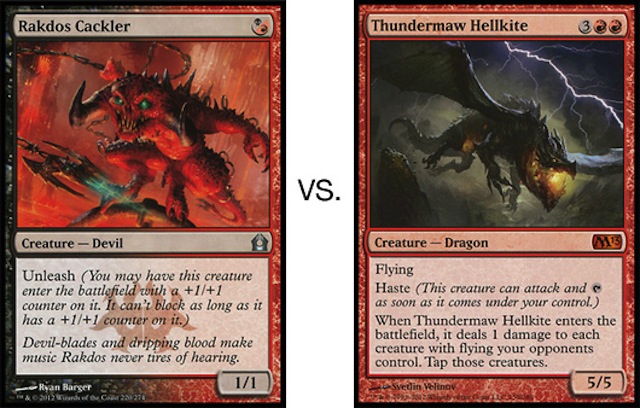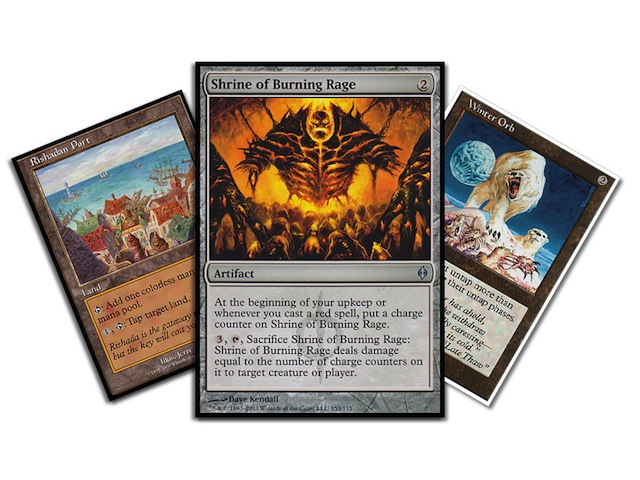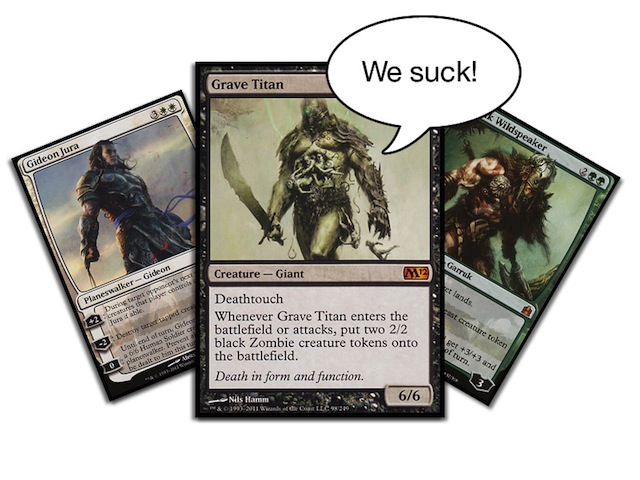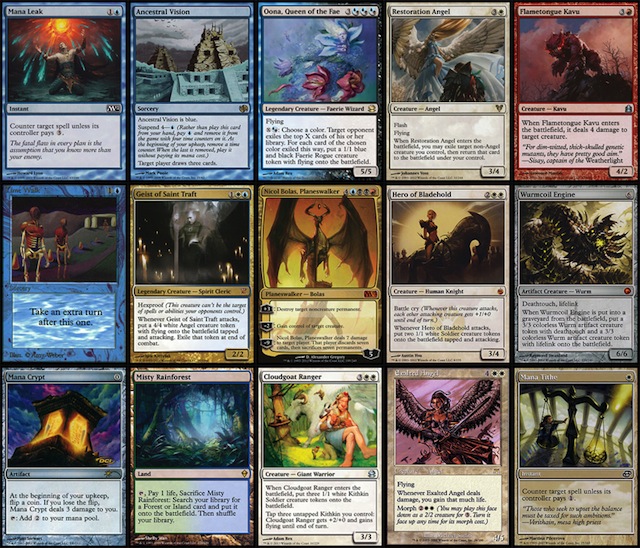By Alex Kaminsky
One of the most nebulous archetypes in Cube is aggro. Generally, most Cube designers will support some form of aggro in two to four colors, with the typical poster children being red and white (followed closely by black). Aggro is a very tricky thing to both balance as a cube designer and draft as a player. This is because aggro in Cube is so different from traditional aggro decks—just hitting a steady stream of efficient dudes will almost never get you there. In this article I’ll dive into the intricacies of building a successful aggro deck and section, and highlight some of my favorite cards for the archetype.
For Drafters
Many Cube novices will enter “autopilot” mode during drafting, seeing a wealth of uber-efficient small creatures and scooping them all up. And guess what? They fall on their faces when it comes to the actual matches. This is because of the extremely high density of efficient mid-range / end-game creatures that other decks can power out. Goblin Guides and Jackal Pups are fantastic when dropped in the early game, but when an opponent plays a turn-three Obstinate Baloth and turn-four Thragtusk, how are you supposed to win?
The answer is simple. Don’t let them get there. Aggro in Cube is much more akin to Legacy aggro decks than it is to any other Constructed format. The best aggro decks in Cube supplement their miniature mana-curve both with tools that keep their opponents off of their threats and reach cards that maximize damage for a minimum mana investment.
In the first category, you have some interesting options. An all-time favorite for my group is the infamous Winter Orb, a card that can easily slot into any aggro deck (thanks to its being colorless) and really throw an opponent off. White aggro decks have access to both Armageddon and Ravages of War, cards that I often see go way too late in draft, considering their power level. I often snap these off as first picks, as they are far more important to the aggro archetype than any Isamaru, Hound of Konda. Tangle Wire is found in many lists and can also fill the role of disruption, especially if dropped before your opponent has had a chance to play any blockers.
In the land section, we gain access to Wasteland, Strip Mine, and Rishadan Port. These are definately skill-tester cards. I have seen them go both first and last pick, depending on the group. Most Cubes run a lot of non-basic lands (one to two per pack, minimum) so Wasteland is sure to have easy targets. These cards are excellent in aggro decks as you rarely need to reach more than five mana (most winning aggro decks should end their curve at four mana, with Hellrider/Hero of Bladehold-type threats) so the ability to not draw dead on a land is a huge boon.
For reach cards, there are some equally excellent options. Some of my “You Shall Not Pass” cards from last week would easily fall under this category, in particular Sulfuric Vortex and Umezawa’s Jitte. Both of these can take an ordinary aggro deck and turn it into something truly terrifying. The Vortex serves a double purpose, by both creating an unblockable, difficult-to-remove clock and preventing aggro’s biggest enemy, life gain. The Jitte, well—the Jitte speaks for itself.
One of my favorite red reach cards is Shrine of Burning Rage. Landing this on turn two makes running out your aggro hand feel so good, because each spell you cast comes with a free one damage attached. The amount of maindeckable artifact removal in Cube is slim, and most of it is attached to a four+ mana creature (Acidic Slime, Indrik Stomphowler, etc.), so the Shrine is rarely dealt with before its prime. I’ve seen it easily hit for 10+ damage in multiple games, and it is an extremely high pick for me in aggro. Another great reach card is Grafted Wargear/Bonesplitter. For a relatively small investment, these two equipments ensure that all of your creatures can get a lot of extra mileage, and are not as much of auto-includes for every deck as much of the other equipment in Cube. Lastly, Cursed Scroll is an excellent colorless way to grind out the last few points of life.
Finishers are something you want to be careful of when drafting an aggro deck. When I draft aggro, I only want one or a maximum of two cards over three mana. It seems like a tall order, but if a Cube is properly tuned for aggro decks it shouldn’t be that much of an issue. You need to make sure you value less exciting cards like Dryad Militant and Elite Vanguard much higher than more splashy/powerful cards like Gideon or Chandra. Below is a quick list of what I consider “acceptable” cards over three mana for aggro decks.
Red
Flametongue Kavu
Hellrider
Hero of Oxid Ridge
Keldon Champion
Koth of the Hammer
Avalanche Riders (Borderline)
Thundermaw Hellkite (Borderline)
White
Elspeth, Knight Errant
Armageddon
Ravages of War
Hero of Bladehold
Baneslayer Angel (Borderline)
Black
Mind Twist
Green
(Note: Green aggro has lost a lot of favor in many cubes. It is much more of a midrange/ramp color.)
Vengevine
Thrun, the Last Troll (Borderline)
Master of the Wild Hunt (Borderline)
Multicolor
Ajani Vengeant
Ral Zarek
Bloodbraid Elf
Rafiq of the Many
Sigarda, Host of Herons (Borderline)
Colorless
Smokestack
Batterskull
For Designers
While perhaps the simplest in play style, aggro is one of the toughest things to build into Cube. The success of the archetype is entirely dependent on building a critical mass of aggro-approved creatures and spells, the grand majority of which are boring one- to two-drops. This means saying goodbye to many splashy four+ drops which you may wish to play in their stead. For this reason, I suggest following an 80/60/60/20/20 split among your colors.
What I mean by this is to have one color 80% dedicated to aggro, another two 60% dedicated, and the last two with only 20%. It is important to have each color touch the strategy as it makes aggro less one-dimensional, and some of the most powerful aggro cards of all time can be found in every color. One thing to note about this ratio model is that the percentages do not refer to how many cards should only work in aggro, but rather how many cards could work in an aggro deck. There is a lot of crossover potential, and cards that are good in multiple deck archetypes like Bloodghast (good in aggro and Smallpox archetypes) or Snapcaster Mage also work to fill your quota. Below is how I personally recommend structuring the split.
Red (80% aggro)
Red is the easiest choice to make the premier aggro color in your Cube. This is because for much of Magic’s history, Wizards has been making excellent cheap beaters for the color. After the easy-includes called out in the article so far, you are left with a ton of efficient burn (Lightning Bolt, Chain Lightning), a ton of great beaters (Plated Geopede, Ash Zealot), and a few higher-end powerhouses (Chandra’s Phoenix, Staggershock). Focus your curve in the one to two range, more so than your other colors, and you should have a pretty solid aggro section put together.
Black/White (60% aggro)
Both black and white have some great aggro lineage to draw upon for Cube. White brings a large number of two-power one-drops to the table (Isamaru, Hound of Konda; Dryad Militant; Savannah Lions; etc.), and black brings a full suite of cheap vampire/zombie types (Bloodghast, Vampire Lacerator, Carnophage). Black also offers some excellent card-draw reach in the form of Dark Confidant, Blood Scrivener, and Phyrexian Arena. White can turn the tide of games with Stoneforge Mystic, and fills red’s dearth of good three-drops with winners like Blade Splicer and Mirror Entity.
Green/Blue (20% aggro)
Before you freak out, please keep in mind that by “aggro” I don’t mean midrange. They are two completely different archetypes, and draft very differently. I personally choose not to include many of green’s one-drop aggro options as compared to the previous three colors. The options just aren’t as strong or exciting. For green’s aggro spread, I instead choose to focus on green’s excellent two- and three-drops such as Tarmogoyf, Scavenger Ooze, and Skinshifter. Blue suprisingly has a number of good options for supplementing aggro decks without sacrificing the control archetype, such as Stasis for an additional Winter Orb effect, Snapcaster Mage, Vendilion Clique, and Man-o-War for tempo/efficient beaters, and multicolor support in the form of cards like Geist of Saint Traft and Psychatog.
After using this strategy as a baseline, play a lot of games and take a lot of notes. What cards are foiling your aggro decks? Where are they coming up short? As much as it hurts, you may need to cut cards that end up being too powerful against aggro decks, or create ways to combat the strategy if it becomes too oppressive. Building aggro into your Cube can be extremely frustrating due to how delicate the balance is between it being too good or bad. I highly recommend you do support it, however, as it is one of the best ways to keep three-or-more-color good stuff decks from dominating your drafts. It forces your drafters to think more critically about their picks and prepare to defend against a greater array of strategies.
That concludes this week’s article, and we’re on to another pick-a-pack. What would you first-pick this week, Cubers?
Alex Kaminsky is one Magic player you don’t want to mess with. He has been playing since Ice Age, swinging in with his Polar Kraken against his Hebrew School peers. With a rich knowledge of the history of the game, and an equally rich collection of cards, it is a no-brainer that he is one of New York’s biggest Cube advocates. He currently lives on the hard streets of Brooklyn with his wife and french bulldog Urza.





